Notes: Bel Royal opened two years after the St. Helier - St Aubin line opened and had a single platform on the up side of the line. In 1910 there was a proposal to extend Victoria Avenue westwards to join the St. Aubin Road to the north west of Bel Royal station. This would involve resite the stations at Millbrook & Bel Royal. A new Millbrook station opened on 15th January 1912 but following the outbreak of WW1 work on the road was suspended.
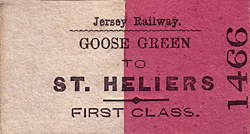 |
In August 1919 the plan to extend Victoria Avenue was revived and the Jersey Railway was asked if they would resite their station at Bel Royal a short distance to the south to make room for the new road. The board expressed the opinion that the new site could only be a temporary one as, when a further extension of the sea wall to Beaumont was contemplated, a second move to |
a permanent site would no doubt become necessary. It referred to a stipulation made in 1912 that the existing station at Bel Royal should be moved at public cost, that a new platform 100 feet longer than the existing one should be provided, that the new track formation be properly ballasted to receive sleepers, and that the new land should be conveyed to the company in exchange for the deeds of the old land, the company only paying the cost of the new sleepers and rails. These conditions were agreed and the new Bel Royal station was opened in 1920.
After closure the station building was dismantled and rebuilt on platform 2 at St. Aubin.
In 2011 two undated tickets were found one issued at Goose Green to St Hellier (above) and the other from First Tower to Goose Green. There has never been a Goose Green station on the Jersey Railway and despite extensive research no documentary evidence has been found relating to Goose Green. As Goose Green is close to Bel Royal it has therefore been assumed that before Bel Royal station opened it was to be called Goose Green and tickets were printed in anticipation. The station however opened as Bel Royal and the tickets were never used.
BRIEF HISTORY OF THE JERSEY RAILWAY
The first proposal for a railway in Jersey came as early as 1845 when a prospectus was published for the creation of a railway company and the building of a new harbour. The directors of the newly formed Jersey Railway Company met for the first time on 8th October that year and proposed a railway line from St Aubin to St Catherine's, where the harbour would be built. The proposed route would have required a costly tunnel under Fort Regent in St Helier.
| Nothing came of this scheme, and there were no further plans for a railway until 1st January 1861 when a Bill for a line between St Helier & St. Aubin was put before the Jersey parliament (the States) by the Jersey Railway Company. The Bill was adopted the following year and was sent for confirmation by Her Majesty (Queen Victoria) in Council. Following a number of |
|
objections, final sanction was continually delayed as the Treasury objected to a clause which allowed the company to take possession of all the seashore below the high water mark without having to pay either the British Government or the States. On 22nd October 1869 a new Bill was submitted; this time there were no delays as it was passed on 22nd October 1869 and confirmed by Her Majesty in Council 20 days later.
This second Bill was very similar to the first but without the contentious clause. It stipulated that work should start within three months and the line should be completed within a year.
The majority of the capital for the line was put up by the contractor Mr E Pickering. For most of its length it would follow the shore line where no sea wall existed. As the route would be very close to the high-water line there was a danger of the track being washed away in bad weather. To safeguard against this Mr Pickering offered to build a sea wall between West Park and St Aubin creating a strip of land sufficiently wide to build the railway, a road and a promenade. This proposal was approved by the States on 11th March 1870, although the railway would be opened before the sea wall was completed.
Despite some minor issues that could have delayed construction there was steady progress, and work was almost finished by September 1870; the first trial run along the line was made on 28th September. This went without mishap, and 300 invited guests rode on the train the following day. Further trials followed, and the line was approved for public use by an engineer appointed by the States on 17th October. There was a ceremonial opening followed by a banquet at Noirmont Manor, the contractor’s residence. 4000 single journeys were made on the opening day, with trains stopping at the three intermediate stations, First Tower, Millbrook and Beaumont.
The standard gauge single-track line was 3¾ miles in length. After leaving St Helier it followed a gentle curve around St Aubin's bay with a passing loop at Millbrook; a short section near La Haule was raised on wooden piles where there was a danger of flooding from the sea.
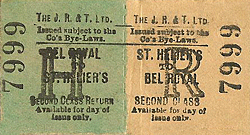 |
In its early years the railway was well used, especially at weekends. Initially there were two locomotives with a third more powerful loco being delivered in June 1871. Three new stations at Cheapside (later renamed West Park), People's Park (short lived) and Bel Royal opened in 1872; another at La Haule had opened by 1876. |
In 1873 work on the sea wall was abandoned due to the high cost: the company felt that an improvement in the existing groynes and culverts would be sufficient to stop the line being washed away. The Committee of Defence took over the building of the wall which was completed between West Park and First Tower in 1880.
Despite the early popularity of the line, the company was declared bankrupt in December 1874. During this period the States Attorney-General ruled that the railway should be kept open until a new proprietor took possession on 24th July 1875. The ownership of the line changed several times in the following few years.
The St Aubin & La Moye Railway
On 15th March 1871 a petition was put before the States on behalf of the owner of the granite quarry at La Moye who wanted to build a standard gauge tramway to carry stone and passengers to St Aubin where the granite would be transported by the Jersey Railway for onward shipping from the docks at St Helier. The Bill was passed on 7th June that year with a time limit of 2 years allowed for construction.
| Once the proposed route had been surveyed, some landowners demanded too much money in compensation for unproductive land of little value, and, at an extraordinary meeting held on 27th June, the Chairman recommended to shareholders that the project should be abandoned unless agreement could be reached with landowners. The greedy landowners |
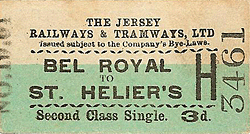 |
backed down, and construction started with an estimate of six to nine months for completion. In March 1874 the company requested an extension of two years and approval for deviations; this resulted in a second Bill which was passed on 3rd September 1874.
By 1st March 1875 construction had progressed well, but in early 1876 the company was declared bankrupt, and all work ceased until the 9th May with the line under new ownership. By the end of July 1877 rails of 3' 6" gauge had been laid between St Aubin and Pont Marquet. It is not known when the decision was made to use 3' 6" gauge instead of standard gauge as originally planned. It is clear that this gauge was used because of the extremely sharp curves and steep gradients between St Aubin and Pont Marquet. The plan was to fit the standard gauge Jersey Railway track with a third rail to allow through running to St Helier.
 |
The first of two locomotives was assembled at the company's engine shed at St Aubin, and it made its first trial run on the line as far as Greenville on 10th September 1877. Within days the line was once again in financial difficulty, and little further work was carried out until January 1882 when ownership passed to Thomas Budd, one of the line’s creditors. During the intervening period protracted negotiations were held regarding a possible merger with the Jersey Railway Company, but nothing initially came of them.
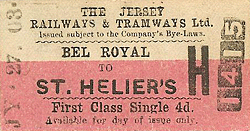 |
On 17th July 1883 Thomas Budd sold his interest in the St Aubin & La Moye Railway to a consortium headed by Viscount Ranelagh; this consortium also purchased the Jersey Railway Company on the same day. The Jersey Railways Company Limited was then established in London to administer both lines, and Thomas Budd was appointed company Chairman. In |
1884 the La Moye line was completed with the first trial train running on 15th March. In February 1884 works started to convert the St Aubin - St Helier line to 3' 6" gauge. This was done in sections with trains kept running during the conversion, passengers being transferred to horse-drawn buses where the conversion was under way.
In July 1884 the La Moye line was inspected by the Jersey Eastern Railway's engineer and as there was still unfinished work at St Aubin. Opening of the line was approved to a temporary terminus near St Aubin Hospital. Once other required improvements had been made the line opened on 30th August 1884. Two further stations were later opened at Pont Marquet and Blanches Banques. The line was single-track throughout with a passing loop at Don Bridge.
There was a large quantity of rock to be blasted before the two lines could join at St Aubin, where a through platform was built alongside the existing station. This opened on 5th August 1885 with six through trains on a weekday from St Helier to Corbière and five in the opposite direction. There were 13 weekday trains from St Helier to St Aubin and 14 in the opposite direction, with a reduced Sunday service on both sections of the line.
On 25th October 1895 the company celebrated the 25th anniversary of the line, but four days later it went into voluntary liquidation as the line had been unable to generate the expected revenue. On 18th January 1896 a new company, The Jersey Railways & Tramways Limited (JR&T) was registered and took over all the assets of the ailing railway from 1st February.
| One of the first improvements the new company made was the provision of a new and much grander station building at St Helier which was completed in 1901; some of the intermediate stations between St. Helier and St Aubin were also improved. The line’s finances began to improve, and the first ever dividend (3%) was paid on ordinary shares in 1897. At this time electric |
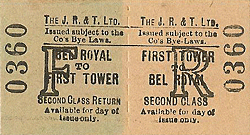 |
traction was discussed along with an extension of the line from La Moye Quarries to a new terminus in the grounds of the Corbière Pavilion. In order to do away with a severe curve to the west of St Aubin station, a new tunnel was excavated and brought into use on 26th December 1898.
Whilst electric traction was never introduced - although it was discussed in detail in 1906 - the Corbière extension was built and was opened to traffic on 1st July 1899.
On 1st January 1912 Millbrook station was relocated a short distance to the south to accommodate road improvements, and in 1920 Bel Royal was relocated to the south for the same reason.
In 1922 the board considered using railcars to reduce running costs. The company accepted an offer from Sentinel-Cammell to try out two on the condition they were delivered to Jersey free of charge. This was agreed, and two railcars of different sizes were ordered for delivery by 1st April 1923.
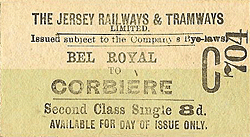 |
On 2nd April 1923 a new bus company, the Jersey Motor Transport Company Limited, started operations with routes running to all parts of the island. This was to have a huge impact on potential revenue, with direct competition coming from routes running from St Helier to St Aubin, St Brelade’s Bay and Corbière. A week before the new routes were introduced, the JR&T |
board decided to reduce fares and open a series of new stopping places to coincide with the introduction of the new railcars at Belozanne Halt, Millbrook Halt, Bel Royal Halt and Beaumont Halt. In order to further lessen the effect of the new competition from buses, they started their own bus service between St Aubin and St Brelade's Bay, timed to connect with departing trains.
The two experimental Sentinel-Cammell steam railcars were delayed for some months, but the first finally arrived and was assembled ready for an inaugural run on 18th June 1923. Unfortunately one of the leading axles snapped. After repairs and other changes had been completed a further successful trial took place on 28th June, and a new summer service was quickly introduced with 32 weekday trains between St Helier and St Aubin, nine of them running on to Corbière. The second railcar was delivered in January 1924, and a third arrived in March 1925.
The railcars soon proved a good investment, and, despite competition from buses, the railway had its most profitable year in 1925 when the total revenue was £23,475, with a dividend of 7% paid on ordinary shares. This upturn was to be short-lived however; by 1928 the company was already feeling the impact of private cars, following a dramatic increase in car ownership on the island. The bus company was also suffering from this competition, and from August 1928 the JR&T took over the Jersey Motor Transport Company, with interchangeable tickets between trains and buses being available, although the two concerns continued to run as separate companies.
 |
In 1929 the directors decided that there was little point in running a parallel road and rail service between St Aubin and Corbière in the winter months, as passengers preferred to travel by bus. A petition was sent to the States on 5th January 1931 allowing the company to suspend its rail service between St Aubin from 1st October to the beginning of May. After receiving official sanction, the Corbière service was suspended from 1st October 1931; no ordinary dividend was paid that year. A further Bill to suspend the winter rail service between St Helier and St Aubin was passed in 1932 with the service being suspended from 1st December until 30th April 1933.
The company made a small profit in 1933 with a 1½ % dividend being paid. Similar winter arrangements were made in 1934/5, but the winter suspension of service between St Helier and St Aubin was brought forward to 1st October. (There was a half hourly rail service for three days before Christmas in 1934, this was never repeated.)
1935 was a better year, with a modest profit and a dividend of 2½ % being paid on ordinary shares. In March 1936 the company requested an inspection of the permanent way before reopening for the summer, and this was undertaken by an engineer from the Great Western Railway. His report concluded that the railway was adequately maintained, and, after some repairs had been made, the line could reopen to traffic after the winter closure; this it did on 1st May 1936, closing again for the winter from 1st October.
Almost all the rolling stock, except the railcars and locomotives, was stored at St Aubin. On 18th October 1936 a fire broke out in a butcher's shop at the front of St Aubin station. Fanned by a strong breeze, the flames quickly spread, engulfing the station and the Terminus Hotel. The hotel was badly damaged, and five shops were destroyed as were the station roof, carriage sheds and 16 carriages, including some recent acquisitions.
| The board immediately decided that rebuilding the station was not a financially viable option, that the railway should close permanently, and that the States should take over all the property and concessions. The remaining rolling stock, rail, sleepers etc. were offered for sale by tender on 5th July 1937, the winning bidder George Cohen paying £5,915; the track was lifted |
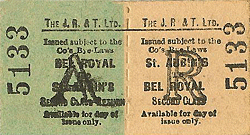 |
shortly afterwards. In order to ensure that the Jersey Motor Transport Company was not part of the impending liquidation, the JMT was transferred to the newly formed company Jersey Road Transport Ltd. An extraordinary general meeting was held on 28th October 1937 to pass resolutions that the JR&T should be wound up and that the directors be authorised to sell all the land to the States of Jersey for £25,000. Outstanding debentures and notes were redeemed and transferred to Jersey Motor Transport, its first directors being the former directors of the JR&T.
During WW2 much of the Jersey Railway was brought back into use by the occupying Germans, being re-laid in metre (3' 3") gauge. The first section of line to be re-laid was from St Helier to Millbrook in c.May 1942 to transport sand for the construction of fortifications around St Aubin Bay. The sand was brought by rail from Grouville Common to Gorey harbour where it was loaded onto barges for the short trip to St Helier to be discharged into wagons on the newly re-laid railway. The line was later extended to Corbière, running from a shunting spur near the old St Helier terminus. There were several branches along its length, one running the length of Albert Pier, another serving an ordnance depot at Millbrook, and a third running north from a point midway between Bel Royal and Beaumont to an electricity generating station at Tesson Mill. The bore of the tunnel at St Aubin was enlarged with storage galleries excavated at right angles to the tunnel. At Pont Marquet there was a new junction, with one line continuing west to Corbière while a new line headed north for 6 miles to Ronez Quarry. (Ronez is the largest granite quarry on the island and is sited in the middle of the north coast.)
Following the liberation of Jersey on 9th May 1945 all the track was quickly removed, the only German track that remains today is embedded in the floor of St Aubin tunnel. Once the track had been removed the line between St Aubin and Corbière was retained for pedestrians, and a programme of planting was begun at the sides of the track. The ‘Railway Walk’ as it is known is still popular with walkers and cyclists today. There is little evidence of any of the former stations along the walk, except at Blanches Banques where part of the platform remains, and at the Corbière terminus which is largely intact - although recently spoilt by the addition of a grotesque glass extension. A number of bridges also survive along the route, as does the tunnel at St Aubin which is a cycle hire shop.
Sources: The Jersey Railway by NRP Bonsor published by Oakwood Press 1969 & 1986 ISBN 978-0853613442. The Jersey Eastern Railway and the Occupation Lines by N R P Bonsor published by the Oakwood Press 1977 and 1986 ISBN 978-0853613459. Railways of the Channel Islands by C. Judge published by Oakwood Press 1992 ISBN 978-0853614340. Thanks also to Jersey resident Chris Totty for his invaluable information, photographs and for driving me round Jersey in June 2010 visiting 38 station sites in 1 day.
Tickets from Michael Stewart, route map drawn by Alan Young, 1914 OS map of Jersey used on most of the station pages received from John Cameron.
A large quantity of documents relating to the Jersey Railways are also held by the Pallot Steam Museum and the Jersey Heritage Trust.
To see other stations on the Jersey Railway click on the station name:
St. Helier (Weighbridge), West Park, People's Park, Bellozanne Halt, First Tower, Millbrook Halt, Millbrook (1st site), Millbrook (2nd site), Bel Royal (2nd site), Bel Royal Halt, Beaumont, Beaumont Halt, La Haule, St. Aubin, St. Aubin (temporary station), Greenville, Pont Marquet, Don Bridge, Blanches Banques, La Moye, The Temporary, Corbière (La Moye Quarries) & Corbière
See also the Jersey Eastern Railway - principal stations are: St. Helier (Snow Hill), & Gorey Pier. |

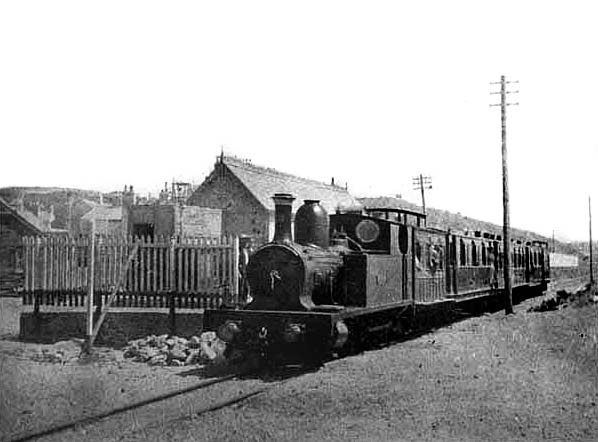

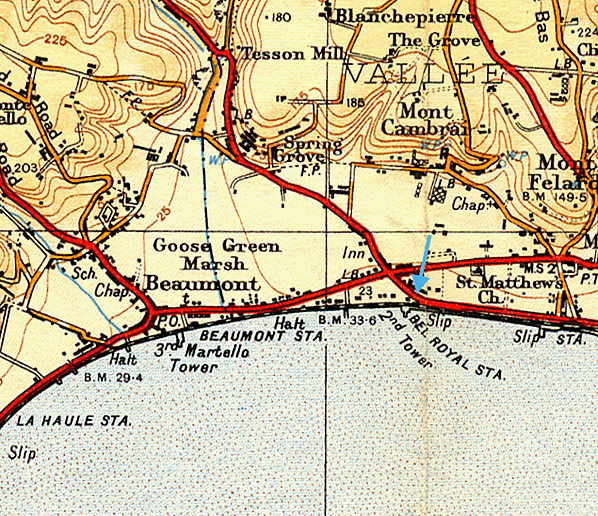
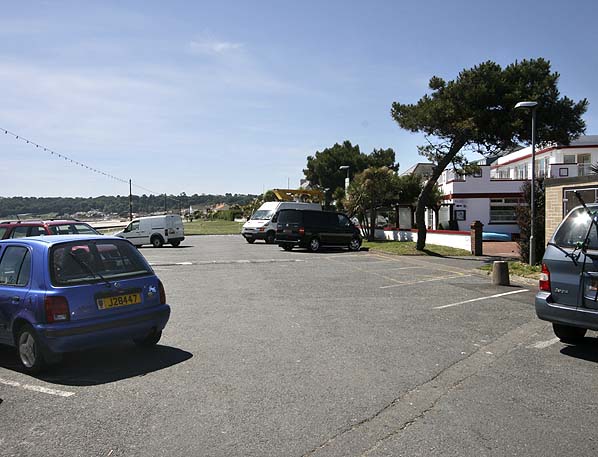

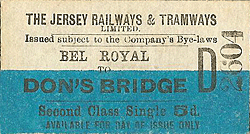





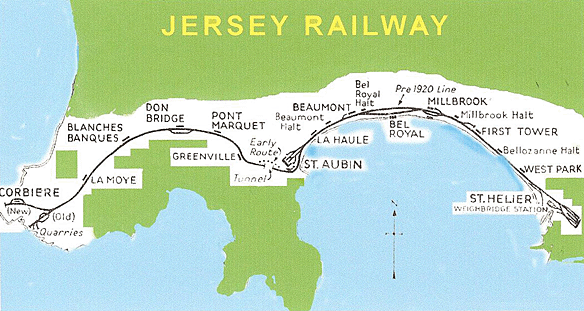




 Home Page
Home Page